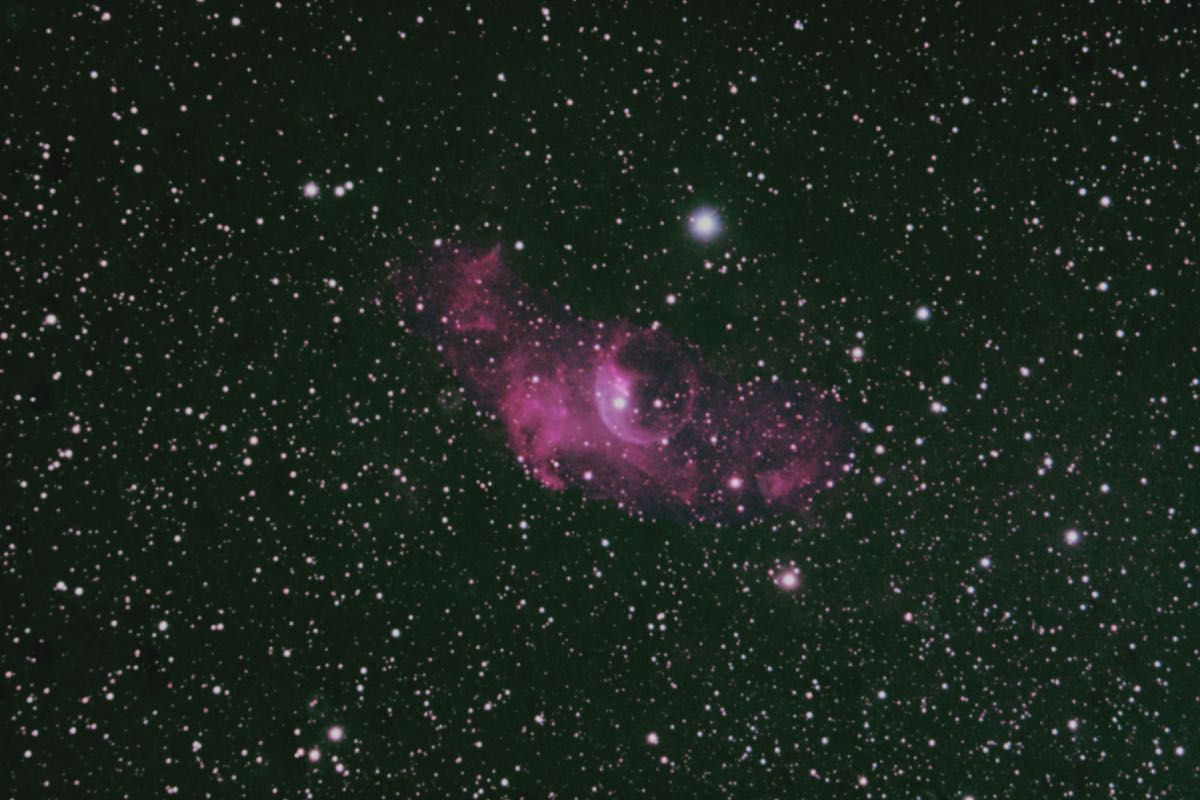On this page are pictures I've taken of deep sky objects like nebulas.
This is the Orion Nebula taken on 11/5/2012 40 second exposure, ISO 1600…

The comparison of the first two images is interesting as it shows what can be done with multiple images that have been post processed. The first image (above) is just a single picture and the one below has been post processed in Images Plus.
11/30/2013 I took this set of pictures on 11/25/2013 of M42 or the Orion Nebula – 11 exposures of 2 minutes each at iso=800. Temp was 23 deg.
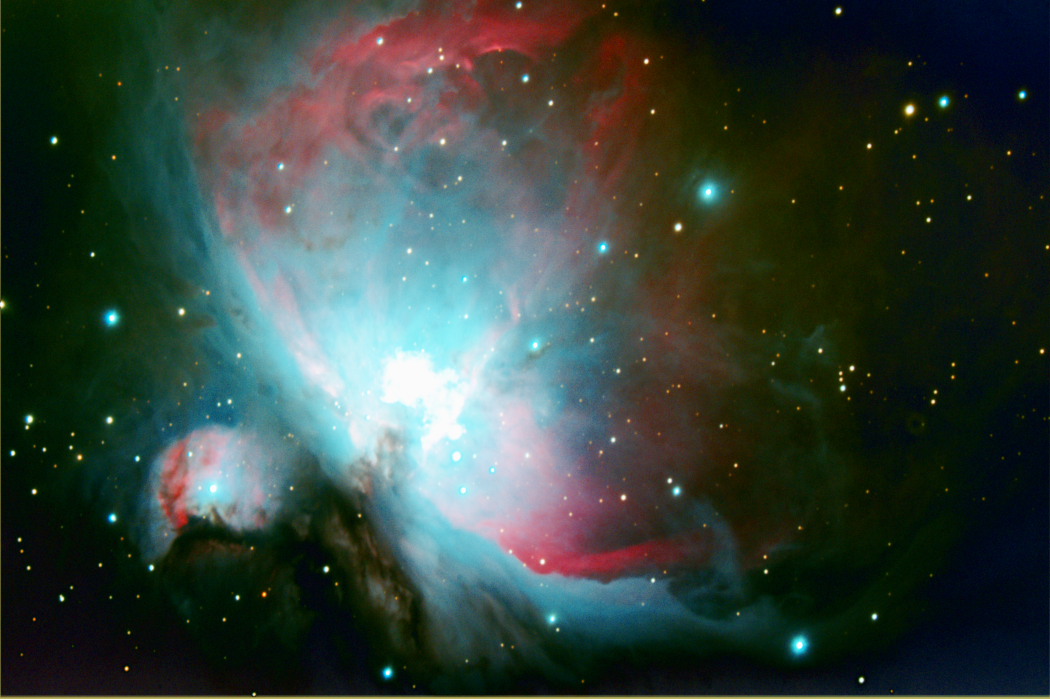
5/3/2013 Last night I took this photo of the Pinwheel Galaxy (M101). It's very faint and really hard to see through the telescope, maybe because it's 21 million light years from Earth. I took 20 5 minute exposures at ISO=400 and 6 darks (5 minute exposures, ISO=400). I stacked the images and post processed them in ImagesPlus.

4/22/2013 M3 taken at ISO of 200, exposure was 300 seconds. The sky was clear, but almost a full moon, so it wasn't very dark.

4/27/2013 Here is a picture of M3 again, 2 minute exposure, ISO 200. This was taken with the focal reducer which changes the telescope from an F10 to an F7. That means the exposure times are cut in half. You can tell that this picture is better focused than the one above.

5/13/2013 Here is M51. The Whirlpool Galaxy (also known as Messier 51a, M51a, or NGC 5194) is an interacting grand-design spiral galaxy in the constellation Canes Venatici. Recently it was estimated to be 23 ± 4 million light-years from the Milky Way Galaxy. I now have 2 hours and 31 minutes of exposures at ISO=400, with darks, flats, and bias frames.


7/15/2015 Another set of images of M51 taken with the Canon 60Da camera. 17 images of 180 sec exposure, ISO=800 with darks, flats and bias frames. Post processed in DSS, and Photoshop.
5/30/2017 Here is my image of M51 or the Whirlpool Galaxy, it is composed of 95 images with a total exposure time of 347 minutes over 4 nights. It was post processed in DSS, PS and IP. From Wikipedia: The Whirlpool Galaxy, also known as Messier 51a, M51 or NGC 5194, is an interacting grand-design spiral galaxy with a Weyfert 2 active galactic nucelus in the constellation Canes Venatici. In the Catalogue of Named Galaxies, it is called the Typhon Canum Benaticorum, after the Greek god Typhon. It was the first galaxy to be classified as a spiral galaxy. Recently it was estimated to be 19 to 27 million light years from the Milky Way.
Here is M102 taken on 5/12/2013 – NGC 5866 (also called the Spindle Galaxy or Messier 102) is a relatively bright lenticular or spiral galaxy in the constellation Draco.
15 x 300 seconds, ISO=400 with darks, flats, and bias frames. Post processed in Deep Sky Stacker then PhotoShop.
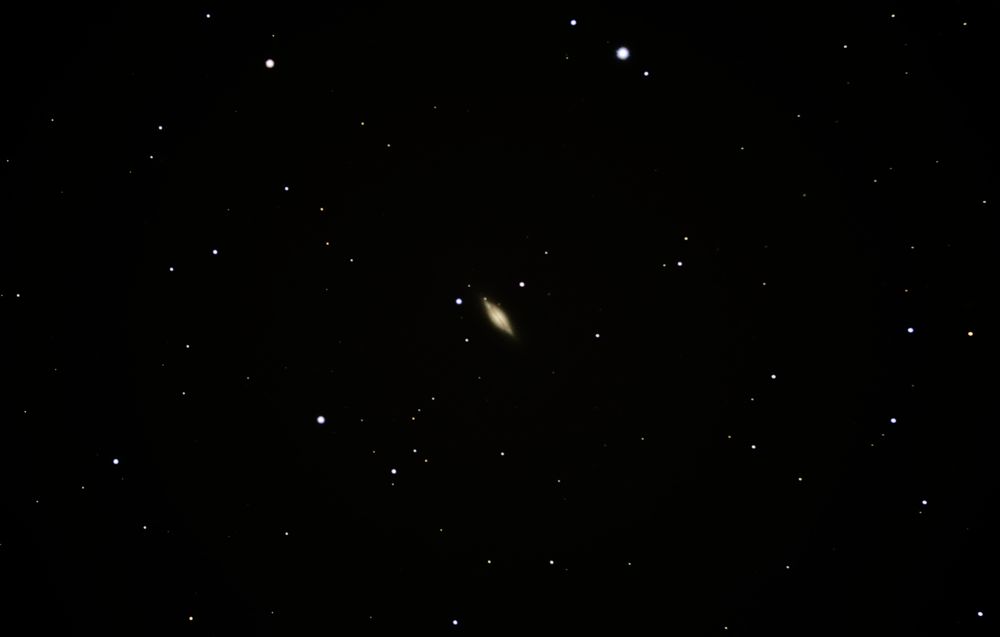
6/1/2013 This is a combination of M81 and M82 composed of 19 two minute exposures. These were then stacked and processed in DeepSkyStacker then Photoshop.
Messier 81 (also known as NGC 3031 or Bode's Galaxy) is a spiral galaxy about 12 million light-years away in the constellation Ursa Major. Due to its proximity to Earth, large size and active galactic nucelus, which harbors a supermassive black hole, Messier 81 has been studied extensively by professional astronomers.
Messier 82 (also known as NGC 3034, Cigar Galaxy or M82) is the prototype nearby starburst galaxy about 12 million light-years away in the constellation Ursa Major. The starburst galaxy is five times brighter than the whole Milky Way and one hundred times brighter than our galaxy's center.
In 2005, the Hubble Space Telescope revealed 197 young massive clusters in the starburst core. The average mass of these clusters is around 2×105 M, hence the starburst core is a very energetic and high-density environment. Throughout the galaxy's center, young stars are being born 10 times faster than they are inside our entire Milky Way Galaxy.

6/1/2013 This is M82 by itself and is composed of 20 two minute exposures. These were then post processed as above.

6/2/2013 Ok – I have three more images – first up is M97 the Owl nebula.
The Owl Nebula (also known as Messier Object 97 or M97 or NGC 3587) is a planetary nebula in the constellation Ursa Major. M97 is regarded as one of the more complex of the planetaries. The 16th magnitude central str has about 0.7 solar mass and the nebula itself about 0.15 solar mass. The nebula formed roughly 6,000 years ago.
The nebula gets its name from the appearance of owl-like "eyes" when viewed through a large (>200 mm) telescope under dark sky conditions with the aid of a so-called "nebula filter." The eyes are also (albeit, not so easily) visible in photographs of the nebula.
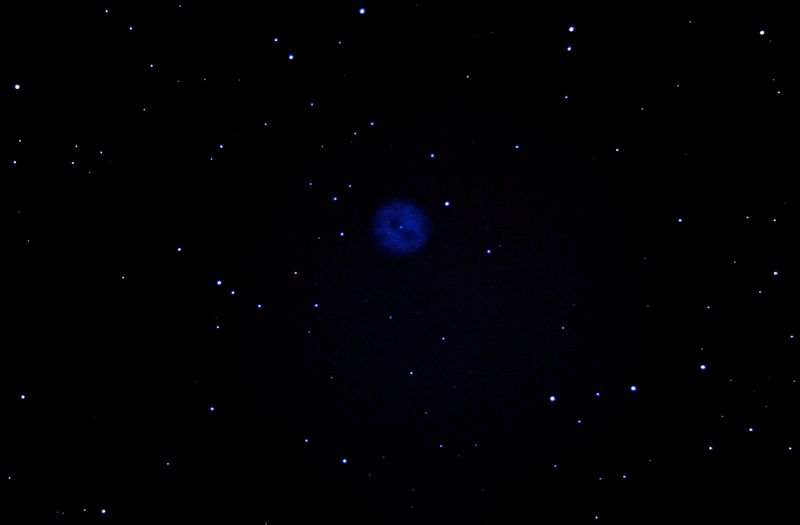
Next is M59, 11 X 180 sec at ISO=400.
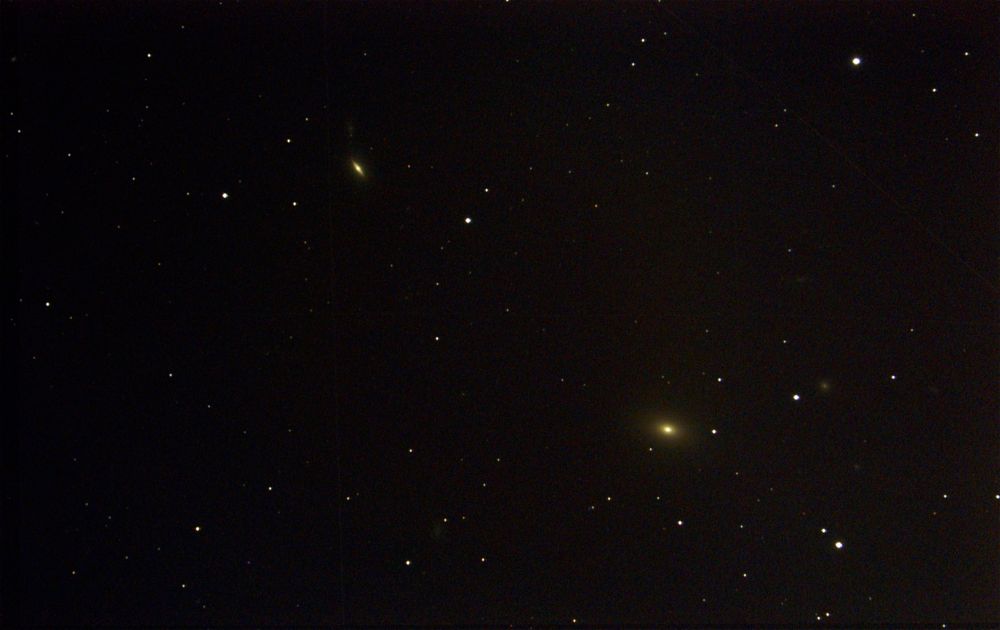
And finally NGC 3065:

This is M13 the great cluster taken on 5/28/13. It is also designated NGC 6025 and sometimes called the Great Globular Cluster in Hercules or the Hercules Globular Cluster. It is a globular cluster of about 300,000 stars in the constellation of Hercules.

6/9/2013 Here is the Iris Nebula. 6 x 240 second exposures at ISO=400 and processed in ImagesPlus. The Iris Nebula, also NGC 7023 and Caldwell 4, is a bright reflection nebula and Caldwell object in the constellation Cepheus. NGC 7023 is actually the cluster within the nebula. It lies 1,300 light-years away and is six light-years across.

7/3/2013 Here is M29 or "the cooling tower" and is composed of 10 4 minute exposures at ISO=400 and processed in ImagesPlus. M29 is about 7000 light years from us.

7/20/13 Here is M5 – a globular cluster with a magnitude of 5.80 in the constellation Serpens and spans 165 light years. This cluster is 13 billion years old and is 24000 lights years from Earth and contains between 100,000 and 500,000 stars. Down in the lower right corner is 5 Sur or HIP 74975. This image is composed of 9 photos of 4 minutes each at ISO of 400. Processing was done in DSS then Photoshop.

I’ve imaged M5, or Messier 5 on 6/13/2018. This picture is composed of the best 80% of 12 images of 180 seconds exposure at ISO of 800. It was then processed in Deep Sky Stacker (DSS) then Photo Shop (PS). Notice the improvement in the image over the one above. This is due to the more advanced camera – Canon 60Da. As of this date, it's getting pretty dated.
Wikipedia: Spanning 165 light-years in diameter, M5 is one of the largest known globular clusters. The gravitational sphere of influence of M5, (i.e. the volume of space in which stars are gravitationally bound to it rather than being torn away by the Milky Way’s gravitational pull) has a radius of 200 light-years. At 13 billion years old, M5 is also one of the eldest globular clusters in the Milky Way Galaxy. Its distance is about 24,500 light-years from Earth, and it contains more than 100,000 stars, as many as 500,00 according to some estimates.

Picture saved with settings applied.
7/22/13 Last night I managed to image about 65 minutes of the Elephants Trunk Nebula or IC1396. Since my camera (Nikon D90) hasn't been modified to astrophotography the nebulosity doesn't show up, but the stars are nice!

8-12-13 Here is IC 1396 again – this time taken with my Canon 60Da astronomy camera. Still no nebulosity – but a lot more stars!
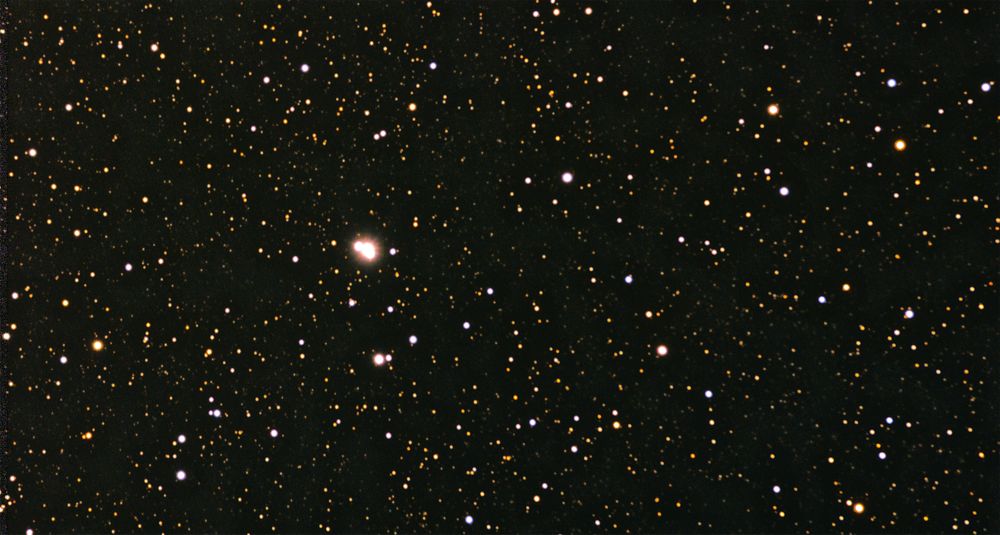
8-15-2013 I imaged this last night through some pretty bad haze from a fire across Utah lake. This is M27 – the Dumbbell Nebula taken with 14 4 minute exposures at ISO of 400 with the Canon 60Da. Post processing was done DSS, NoiseWare, PhotoShop then iphoto. The Dumbbell Nebula is a planetary nebula in the constellation Vulpecula, and is about 1360 light years from us.
.

8/13/2016
This is a combined photo where I added 44 additional minutes from last night to bring the total to 3 hours 13 minutes.
Revised 9/11/16 to include only the best of the photos, the rest were excluded.
9/16/2013 This is M31 or the Andromeda Galaxy. It is 2.5 million light years from Earth and is the nearest spiral galaxy to our Milky Way galaxy. This image is composed of 40 2 minute exposures at ISO 800, and 13 3 minute exposures at ISO=800 for a total of 1 hr and 59 minutes, and stacked with 10 darks, bias and flat frames in DSS.


10-7-13 Last night it was cold – got down to 42 deg F and I wasn't dressed for it. Anyway I had a good night of imaging. This first is the North American Nebula or NGC700 – or at least part of it. This is an emission nebula in the constellation Cygnus, close to Deneb. The remarkable shape of the nebula resembles that of the continent of North America (you can just see part of the nebula here). This nebula is large, covering more than four times the size of the full moon. This picture is composed of 11 10 minute images taken at ISO of 800 and processed in ImagesPlus.
This the second image I took on 10-6-13. This image is of M33 and was processed in ImagesPlus from 9 3 minute images. M33 is also called the Triangulum Galaxy, and is 3 million light years from Earth. It is sometimes informally called the Pinwheel Galaxy, a nickname it shares with M101. The Triangulum Galaxy is the third largest member of the local group of galaxies, which includes the Milky Way, the Andromeda Galaxy and about 30 other smaller galaxies. It is one of the most distant permanent objects that can be viewed with the naked eye.

12/19/2013 This image of M37 was taken on Nov 26th.
3 images of 180 seconds each at ISO=1600 with darks, flats, and bias frames added. Post processed in ImagesPlus.
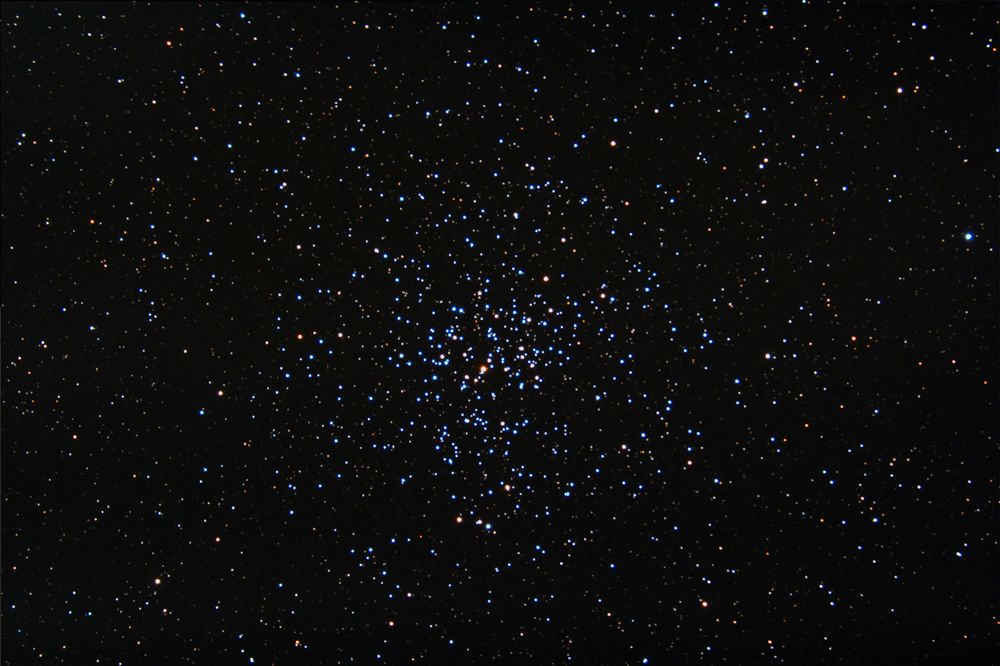
M92 taken on 9/19/2014 and is a globular cluster and lies about 26,700 light years from earth. This image is composed of 11 3 minute exposures at ISO=800.10-9-15 This was processed with Images Plus and Photo Shop.
10/9/2015 It's been a while, but I was able to get out and image for a few hours. I had some mount connections problems, but was able to get in 20 x 120 sec images of M57 (or the Ring Nebula) at ISO=800. This was then processed in DSS then Photo Shop followed by Iphoto. The Ring Nebula (also catalogued as Messier 57, M57or NGC6720) is a planetary nebula in the northern constellation of Lyra and is 2300 light years from earth. Such objects are formed when a shell of ionized gas is expelled into the surrounding Interstellar medium by a red giant star, which was passing through the last stage in its evolution before becoming a white dwarf.
12/19/15
Last night I spent 2 hours photographing the Veil Nebula (NGC 6995). The large star in the middle exploded 5000 to 8000 years ago. This nebula is about 1500 light years from earth. The photo is composed of 1 hour and 42 minutes of exposures of 2 or 3 minutes of duration (ISO = 800 and 1600) taken on the nights of 10/14/15 and 12/18/15. Last night was the first time I used my new 10Micron GM1000HPS telescope mount. It performed flawlessley! What a fantastic piece of art.
7-18-2016
To deep sky observers, the group of NGC 5985, NGC 5982 and NGC 5981 is commonly known as the “Draco Trio”. Two barred spirals at different angles and a face on elliptical all in the same field of view is a rare sight and makes for a beautiful celestial portrait. The beautiful spiral is NGC 5985. The proper designation for the elliptical galaxy is NGC 5982. The catalog number for the edge-on is NGC 5981. While these galaxies span huge amounts of light years apart, they share telescopic space at RA: 15h 38m 40s Dec: +59°21’22” as a center and share photons in the eyepiece at around 25 arc minutes. While the Draco group is far too small to be considered its own galaxy cluster and has never been classified as a compact group, oddly enough all three are around 100 million light years away from the Sol System.
These photos were taken over the last few days and consist of 180 sec exposures at ISO=1600 for a total time of about 1 hr and 45 minutes, they were processed using DSS then Photo Shop.
The Eagle Nebula (catalogued as Messier 16 or M16, and as NGC 6611, and also known as the Star Queen Nebula and The Spire) is a young open cluser of stars in the constellation Serpens, discovered by Jean-Philippe de Cheseaux in 1745–46. Both the "Eagle" and the "Star Queen" refer to visual impressions of the dark silhouette near the center of the nebula, an area made famous as the "Pillars of Creation" photographed by the Hubble Space Telescope. The nebula contains several active star-forming gas and dust regions, including the Pillars of Creation. This photo is composed of 2 exposures of 20 minutes at ISO=200 and processed in DSS then photoshop.
8/14/2016
Last night I added 44 more minutes for a total of 84 minutes – this image is processed with DSS and PS. The close proximity of a very bright moon resulted in short exposure length of 4 minutes at ISO of 200.
9-10-16 I've added 88 more minutes for a total now of 3 hours and 46 minutes. These were processed in DSS then PhotoShop.
The Eagle Nebula (catalogued as Messier 16 or M16, and as NGC 6611, and also known as the Star Queen Nebula and The Spire) is a young open cluser of stars in the constellation Serpens, discovered by Jean-Philippe de Cheseaux in 1745–46. Both the "Eagle" and the "Star Queen" refer to visual impressions of the dark silhouette near the center of the nebula, an area made famous as the "Pillars of Creation" photographed by the Hubble Space Telescope.
The nebula contains several active star-forming gas and dust regions, including the Pillars of Creation. Evidence from the Spitzer Telescope suggests that the pillars in M16 may already have been destroyed by a supernova explosion. Hot gas observed by Spitzer in 2007 suggests that the area was disturbed by a supernova that exploded some 8000 to 9000 years ago. Due to the distance of the nebula, the light from the supernova would have reached Earth between 1000 and 2000 years ago. The more slowly moving shock wave from the supernova would have taken a few thousand years to move through the nebula, and would blow away the delicate pillars – but the light showing us the destruction will not reach the Earth for another millennium.
4/20/2017 I imaged this last night – 12 images of 240 seconds at iso=800, then stacked and post processed. NGC 2403 (also Caldwell 7) is an intermediate spiral galaxy in the constellation Camelopardalis. NGC 2403 is an outlying member of the M81 Group, and is approximately 8 million light-years distant. It bears a striking similarity to M33, being about 50,000 light years in diameter and containing numerous star-forming H II regions. The northern spiral arm connects it to a Star forming region NGC 2404. NGC 2403 can be observed using 10×50 binoculars.
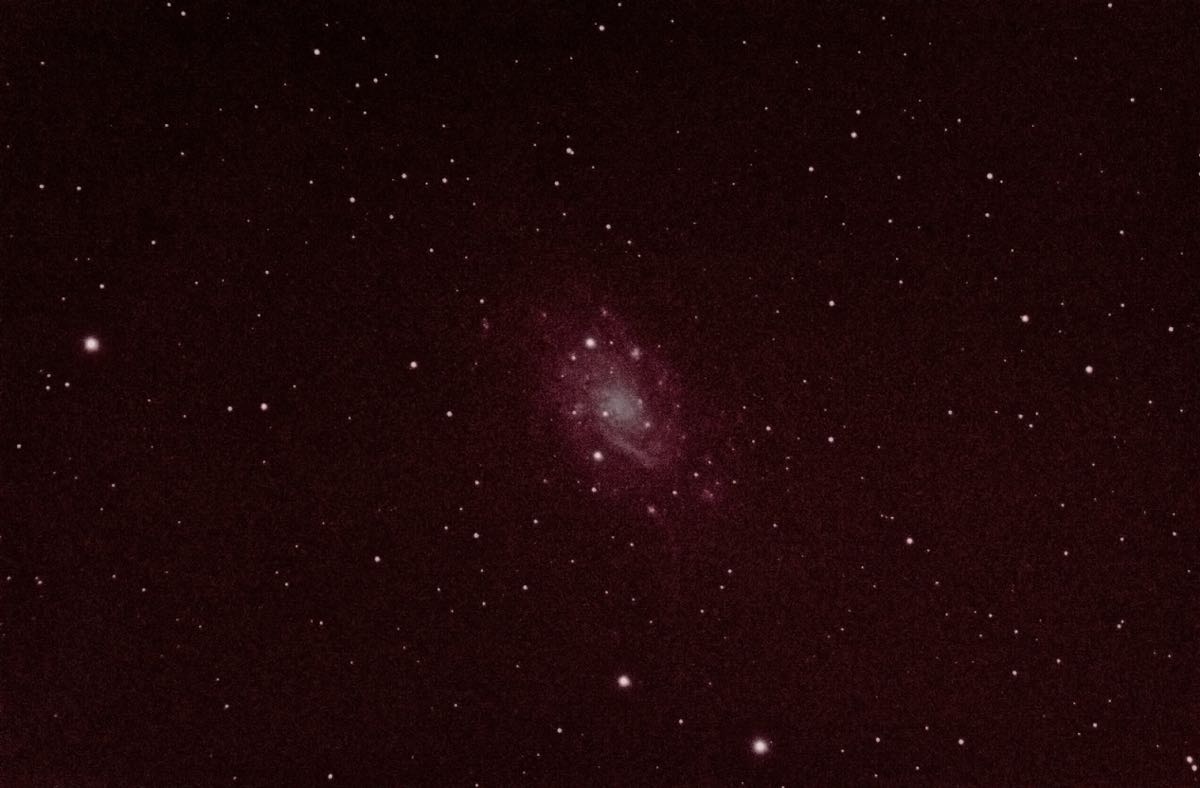 10/24/2017This is NGC7635 imaged tonight (10/24/17), and is composed of 50 2.5 minute exposures. A little bit about the image: Blown by the wind from a massive star, this interstellar apparition has a surprisingly familiar shape. Cataloged as NGC 7635, it is also known simply as The Bubble Nebula. Although it looks delicate, the 7 light-year diameter bubble offers evidence of violent processes at work. Above and left of the Bubble's center is a hot, O-type star, several hundred thousand times more luminous and around 45 times more massive than the Sun. A fierce stellar wind and intense radiation from that star has blasted out the structure of glowing gas against denser material in a surrounding molecular cloud. The intriguing Bubble Nebula and associated cloud complex lie a mere 7,100 light-years away toward the boastful constellation Cassiopeia.
10/24/2017This is NGC7635 imaged tonight (10/24/17), and is composed of 50 2.5 minute exposures. A little bit about the image: Blown by the wind from a massive star, this interstellar apparition has a surprisingly familiar shape. Cataloged as NGC 7635, it is also known simply as The Bubble Nebula. Although it looks delicate, the 7 light-year diameter bubble offers evidence of violent processes at work. Above and left of the Bubble's center is a hot, O-type star, several hundred thousand times more luminous and around 45 times more massive than the Sun. A fierce stellar wind and intense radiation from that star has blasted out the structure of glowing gas against denser material in a surrounding molecular cloud. The intriguing Bubble Nebula and associated cloud complex lie a mere 7,100 light-years away toward the boastful constellation Cassiopeia.
4/27/2018 Last night the sky was clear for the first time in several days, so I took my telescope out and imaged NGC2403 (even though I had to compete with a very bright moon and the lighted Y). This represents 25 images of 2 minutes each at ISO of 800.
NGC 2403 (also Caldwell 7) is an intermediate spiral galaxy in the constellation Camelopardalis. NGC 2403 is an outlying member of the Messier81 Group, and is approximately 8 million light-years distant. It bears a striking similarity to Messier33, being about 50,000 light years in diameter and containing numerous star-forming H II regions. The northern spiral arm connects it to the star forming region NGC 2404. NGC 2403 can be observed using 10×50 binoculars. (Wikipedia)

6/18/2018 I imaged M81 again and acquired 11 shots at an exposure of 6 minutes with ISO=400 with a partial moon. Here is the image with the data I acquired on 5/7/18 in which I imaged 30 shots of 2 minute exposures at ISO=800 on a clear moonless night. It was then post processed in DSS (Deep Sky Stacker) and Photo Shop.
Messier 81 (also known as NGC 3031 or Bode's Galaxy) is a spiral galaxy about 12 million light-years away, in the constellation Ursa Major. Due to its proximity to Earth, large size, and active galactic nucleus (which harbors a 70 million M☉ supermassive black hole), Messier 81 has been studied extensively by professional astronomers. The galaxy's large size and relatively high brightness also make it a popular target for amateur astronomers. (Wikipedia)

I imaged this nebula (NGC 6946) last night (6/3/2018). It consists of the best 70% of 10 images each with an exposure of 300 seconds, the ISO was set to 800. Post processing was in DSS, PS and IP. The night was clear with no moon, very nice for my area in Provo Utah.
From Wikipedia: NGC 6946 is a face-on intermdeiate spiral galaxy with a small bright nucleus, whose location in the sky straddles the boundary between the northern consetllations of Cepheus and Cygnus. Its distance from Earth is about 22.5 million light-years or 6.8 megaparsecs, similar to the distance of M101 (NGC 5457) in the constellarion Ursa Major. Both were once considered to be part of the Local Group. But are now known to be among the dozen bright spiral galaxies near the Milky Way but beyond the confines of the Local Group. NGC 6946 lies within the Virgo Supercluster.
Discovered by William Herschel on 9 September 1798, this well-studied galaxy has a diameter of approximately 40,000 light-years, about one-third of the Milky Way's size, and it contains roughly half the number of stars as the Milky Way. The galaxy is heavily obscured by instellar matter as it lies quite close to the glalctic plane of the Milky Way. Due to its prodigious star formation it has been classified as an active starburst galaxy.
Various unusual celestial objects have been observed within NGC 6964. This includes the so-called 'Red Ellipse' along one of the northern arms that looks like a super-bubble or very large supernova remnant, and which may have been formed by an open cluster containing massive stars. There are also two regions of unusual dark lanes of nebulosity, while within the spiral arms several regions appear devoid of stars and gaseous hydrogen, some spanning up to two kiloparsecs across. A third peculiar object, discovered in 1967, is now known as "Hodge's Complex”. This was once thought to be a young supergiant cluster, but in 2017 it was conjectured to be an interacting dwarf galaxy superimposed on NGC 6964.
 On 6/8/2018 I imaged Messier 65 (on the right) and and 66 (on the left). From Wikipedia: Messier 65 (also known as NGC 3643) and Messier 66 (also known as NGC 3627) are intermediate spiral galaxies about 35 and 36 million lightyears away (respectively) in the constellation Leo. They were discovered by Charles Messier in 1780. These along with NGC 3628 form the Leo Triplet, a small group of galaxies.
On 6/8/2018 I imaged Messier 65 (on the right) and and 66 (on the left). From Wikipedia: Messier 65 (also known as NGC 3643) and Messier 66 (also known as NGC 3627) are intermediate spiral galaxies about 35 and 36 million lightyears away (respectively) in the constellation Leo. They were discovered by Charles Messier in 1780. These along with NGC 3628 form the Leo Triplet, a small group of galaxies.
The image below is composed of the best 70% of 36 pictures (lights), each taken with an exposure of 100 seconds at an ISO of 1600. They were post processed in Deep Sky Stacker followed by Photo Shop.

Last night on 6/11-12/2018 I imaged the Iris Nebula. This image is composed of 27 7-minute exposures at ISO of 1600 using a skyglow filter to remove the local light pollution. It was then processed in Photo Shop. I didn’t get to bed until 4 am. It was a great night.
From Wikipedia: The Iris Nebula, also NGC 7023 and Caldwell 4, is a bright reflection nebula and Caldwell object in the constellation Cepheus. NGC 7023 is actually the cluster within the nebula, LBN 487, and the nebula is lit by a magnitude +7 star, SAO 19158. It shines at magnitude +6.8. It is located the Mira-type variable star T Cephi, and near the bright magnitude +3.23 variable star Beta Cephei(Alphirk). It lies 1,300 light-years away and is six light-years across.
[caption id="attachment_9276" align="alignnone" width="1200"]
[caption id="attachment_9278" align="alignnone" width="1200"] Picture saved with settings applied.
Picture saved with settings applied.
I imaged NGC2403 on 4/19/2017. This photo is composed of 11 exposures of 240 seconds each at ISO=800. Post processing was done in DSS then PS.
NGC 2403 (also Caldwell 7) is an intermediate spiral galaxy in the constellation Camelopardalis. It is and outlying member of the M81 group and is approximately 8 million light-years distant. It bears a striking similarity to M33, being about 50,000 light years in diameter and containing numerous star-forming H II regions.

Picture saved with settings applied.










